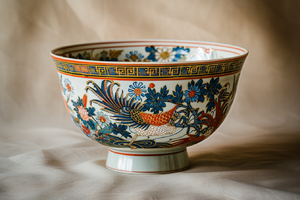Ko-Imari
Ko-Imari

Ko-Imari (nghĩa đen là Imari cổ) ám chỉ phong cách đồ sứ Imari Nhật Bản sớm nhất và mang tính biểu tượng nhất, chủ yếu được sản xuất vào thế kỷ 17. Những món đồ sứ này được sản xuất tại thị trấn Arita và xuất khẩu từ cảng Imari gần đó, chính là nguồn gốc của tên gọi Ko-Imari. Ko-Imari đặc biệt nổi bật với phong cách trang trí năng động và ý nghĩa lịch sử trong thương mại đồ sứ toàn cầu thời kỳ đầu.
Bối cảnh lịch sử
Đồ gốm Ko-Imari xuất hiện vào đầu thời kỳ Edo, khoảng những năm 1640, sau khi đất sét sứ được phát hiện ở vùng Arita. Ban đầu, chịu ảnh hưởng từ đồ sứ lam trắng Trung Quốc, các thợ gốm Nhật Bản địa phương bắt đầu phát triển phong cách riêng. Khi xuất khẩu đồ sứ của Trung Quốc suy giảm do sự sụp đổ của nhà Minh, đồ sứ Nhật Bản bắt đầu lấp đầy khoảng trống trên thị trường quốc tế, đặc biệt là thông qua giao thương với Công ty Đông Ấn Hà Lan.
Tính năng chính
Những phẩm chất đặc biệt của Ko-Imari bao gồm:
- Bold and colorful designs, typically combining cobalt blue underglaze with overglaze enamels in red, green, and gold.
- Dense and symmetrical decoration covering nearly the entire surface, often described as richly ornate or even opulent.
- Motifs such as chrysanthemums, peonies, phoenixes, dragons, and stylized waves or clouds.
- Thick porcelain body compared to later, more refined pieces.
Ko-Imari ware was not intended solely for domestic use. Many pieces were tailored to suit European tastes, which included large plates, vases, and garnitures for display.
Export and European Reception
Ko-Imari ware was exported in large quantities throughout the 17th and early 18th centuries. It became a fashionable luxury item among European elites. In palaces and aristocratic homes across Europe, Ko-Imari porcelain adorned mantelpieces, cabinets, and tables. European porcelain manufacturers, particularly in Meissen and Chantilly, began producing their own versions inspired by Ko-Imari designs.
Evolution and Transition
By the early 18th century, the style of Imari ware began to evolve. Japanese potters developed more refined techniques, and new styles such as Nabeshima ware emerged, focusing on elegance and restraint. The term Ko-Imari is now used to specifically distinguish these early exported works from later domestic or revival pieces.
Legacy
Ko-Imari remains highly valued by collectors and museums worldwide. It is considered a symbol of Japan’s early contribution to global ceramics and a masterwork of Edo-period craftsmanship. The vivid designs and technical achievements of Ko-Imari continue to inspire both traditional and contemporary Japanese ceramic artists.
Relationship to Imari Ware
While all Ko-Imari ware is part of the broader category of Imari ware, not all Imari ware is considered Ko-Imari. The distinction lies primarily in the age, style, and purpose. Ko-Imari specifically refers to the earliest period, characterized by its dynamic energy, export orientation, and richly decorated surfaces.
